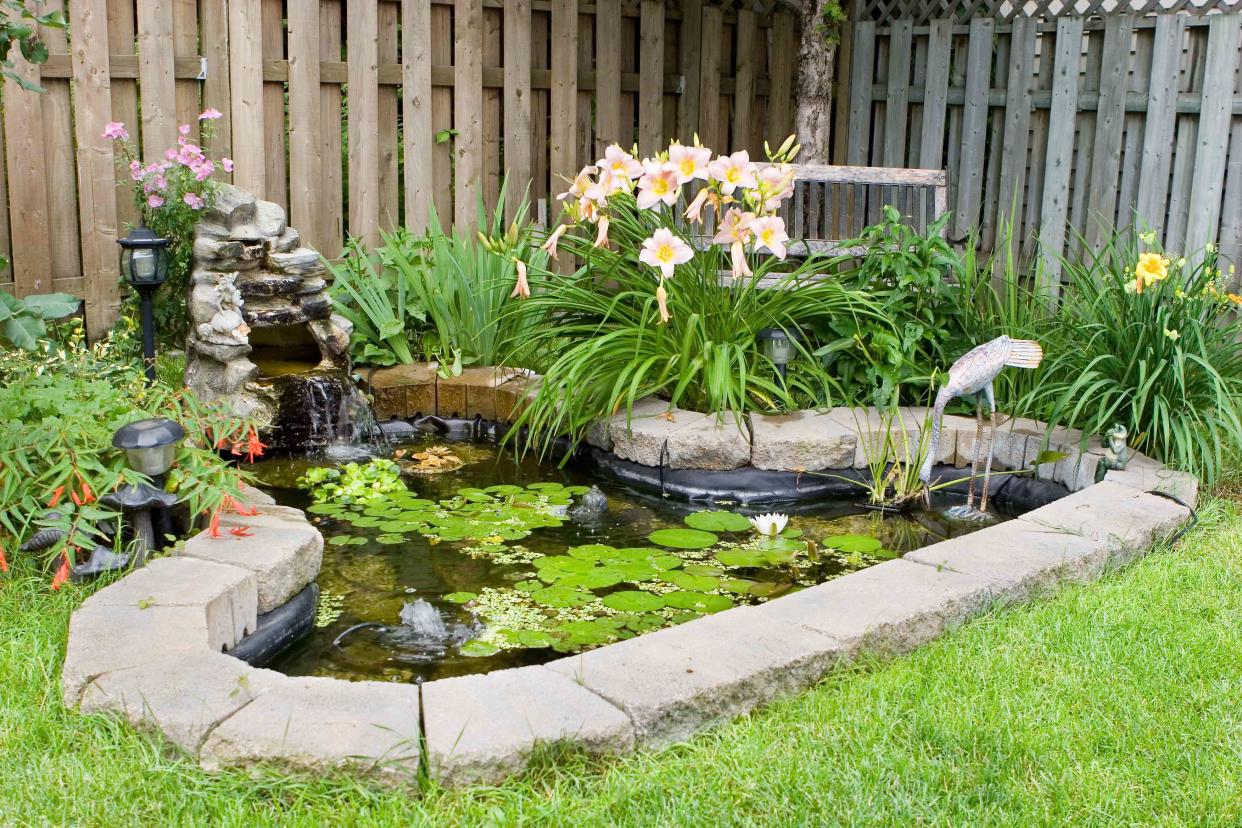Pond Maintenance: An Easy Annual Schedule for Cleaning and More

ImageegamI / Getty Images
Pond maintenance is an essential part of owning a garden pond. Ponds depend on regular care to keep the water fresh and clear, both for users and for dependent aquatic plants and pond life such as koi.
Schedule | Task |
Every day or two | Skim |
Every week | Add water |
Three or four times a year | Tend pond plants; landscape around the pond; clean the filter |
Once or twice a year | Drain pond; maintain pump; winterize |
Skim the Pond
With the net skimmer, remove leaves, insects, pine cones, and other debris. To skim, place the net about halfway into the water and move it continuously back and forth. Empty the net when it is about a quarter full.
It's essential to manually skim off as much debris as possible since the electric skimmer can't handle all debris—especially the larger pieces. Decomposing organic matter, too, changes the makeup of the water, so it's important to remove the items before they break down.
Clean the Water Filter
The media filter in the pond pump collects floating debris and cycles clean water out. When the filter becomes clogged, it cannot collect particulates as effectively. Clogged filters make pumps work harder, making them more prone to failure.
First, turn off and unplug the pump. Remove the filter media and dispose of it. While you have the pump open, clean the filter with a soft brush to remove debris or algae. Place a fresh sheet of filter media in the pump.
Maintain the Water Level
Pond water evaporates no matter the season. As the seasons roll into spring and summer, evaporation picks up pace. Keep the water level topped off to maintain water quality.
Add water with a garden hose or by hand with a five-gallon bucket. To eliminate manual fills, purchase a pond auto top up device that attaches to a garden hose. When the water level drops below a designated level, the device opens up the water flow.
Tend the Pond's Plants
Break up clustered aquatics like water lilies and lotus. Remove dead or dying plants. Prune excessive plant growth. Add new plants where needed.
It's vital to maintain plants in the pond to keep out debris and avoid decomposition. Aim to have at least 50-percent of the pond surface clear for better oxygenation.
Manage the Algae
Not all pond water needs to be crystal-clear. Small amounts of algae provide food for microscopic zooplankton, a valuable nutrient for pond fish. But algae blooms create an unhealthy, unpleasant environment for animals, plants, and humans.
Introduce aquatic plants to provide shade, which slows algae growth. Keep those plants in good shape and be sure to break them apart every so often. Ensure the ultraviolet clarifier is in good working order (or install one, if you don't have one). Submerged UV clarifiers kill algae blooms before they can start. Occasionally, pour algaecide diluted with water into the pond.
Tip
Do not use pool shock treatment or chlorine. Algaecides contain copper, sulfates, salts, and other ingredients safe for garden ponds.
Landscape Around the Pond
Plants surrounding the pond can find their way into the water through overgrowth, and rocks, dirt, and leaves can get kicked or blown in.
Prune back the plants surrounding the garden pond, rake dirt and rocks away from the sides of the pond, and make sure that the flat rocks that cover the edges of the pond liner are in place.
Winterize the Pond
With inclement weather and an increasing amount of debris, fall and winter take a heavy toll on garden ponds. Severe cold can harm pond pumps and other mechanical parts.
Start winterizing the pond in early autumn. Skim out debris and clean the pond filter. Shut off the pump. Lay pond netting. After all the leaves have fallen, remove the netting. Prune foliage from around the pond. If you decide to shut down the pond for the winter, unplug and cover the pump.
Drain the Pond
When the pond is full, it's difficult to thoroughly clean it and maintain the liner. Pond water, too, can benefit from being changed out every so often. Drain the pond once a year or as needed.
Drain the water with the pond drain or pump it out with a submersible pump. Let the pond dry out. Remove rocks from the bottom. Hose down the side and bottom of the pond (do not use cleaning fluids). Use a shop vacuum to remove dirty water. Check the pond liner for tears, punctures, or signs of deterioration.
Frequently Asked Questions
What can I put in my pond to keep it clean?
Put diluted algaecide in the pond to keep it clean. Regular treatments with algaecide prevent algae bloom. An electric, submersible UV clarifier is a good supplement for preventing algae growth.
Is a pond high maintenance?
Ponds are generally considered to be high maintenance. Developing a maintenance schedule makes it easier to keep up with maintenance chores. An electric pond filter helps to keep the water clean.
What are the disadvantages of ponds?
One disadvantage of ponds is that maintaining the water quality can be challenging. As the sunnier months come along, more algae will grow. Ponds also need to be filtered or skimmed on a regular basis.
Read Next: 25 Small Ponds With Waterfalls Worth Adding to Your Yard
Read the original article on The Spruce.

